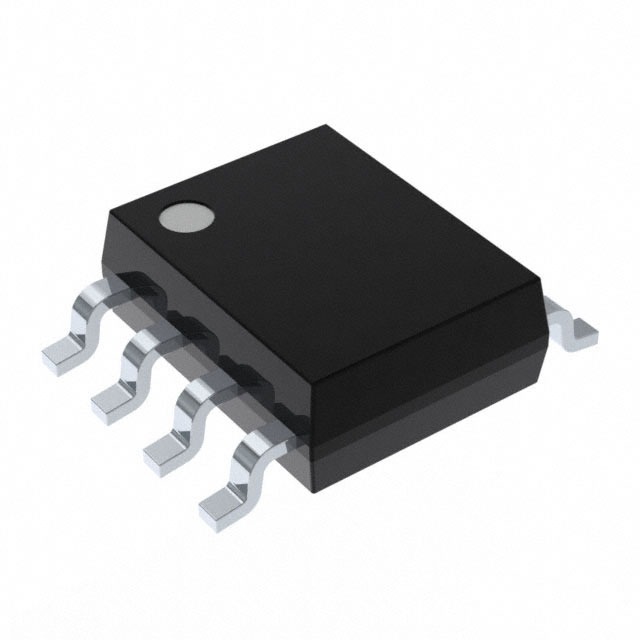MAX9107ESA
Product Overview
- Category: Integrated Circuit (IC)
- Use: High-Speed Differential Line Receiver
- Characteristics: Low-power, high-speed, differential input, single-ended output
- Package: 8-pin SOIC (Small Outline Integrated Circuit)
- Essence: MAX9107ESA is a high-performance differential line receiver designed for use in high-speed data communication systems.
- Packaging/Quantity: Available in tubes or reels, with a quantity of 250 units per tube/reel.
Specifications
- Supply Voltage Range: +4.5V to +5.5V
- Operating Temperature Range: -40°C to +85°C
- Input Common-Mode Voltage Range: -0.5V to +5.5V
- Output Voltage Swing: 0V to VCC-1.5V
- Maximum Input Data Rate: 500Mbps
- Propagation Delay: 2.5ns (typical)
Pin Configuration
The MAX9107ESA IC has the following pin configuration:
```
| | --| VCC GND |-- Pin 1: Power supply (+5V) --| IN+ NC |-- Pin 2: Non-inverting differential input --| IN- OUT |-- Pin 3: Inverting differential input / Single-ended output --| GND NC |-- Pin 4: Ground --| NC NC |-- Pin 5: Not connected --| NC NC |-- Pin 6: Not connected --| NC NC |-- Pin 7: Not connected --| NC VCC |-- Pin 8: Power supply (+5V) |___________| ```
Functional Features
- High-speed differential line receiver capable of handling data rates up to 500Mbps.
- Low-power consumption, making it suitable for battery-powered applications.
- Differential input allows for noise rejection and improved signal integrity.
- Single-ended output simplifies interfacing with other ICs or devices.
Advantages
- High-speed operation enables reliable data transmission in high-bandwidth applications.
- Low-power consumption extends battery life in portable devices.
- Differential input provides excellent common-mode noise rejection.
- Single-ended output simplifies system integration.
Disadvantages
- Limited voltage swing on the output may require additional amplification for certain applications.
- Not suitable for low-speed or low-bandwidth applications where simpler and lower-cost alternatives exist.
Working Principles
The MAX9107ESA is designed to receive high-speed differential signals and convert them into single-ended outputs. It utilizes differential input circuitry to reject common-mode noise and improve signal integrity. The internal circuitry amplifies and conditions the received signals, providing a clean and reliable output.
Application Field Plans
The MAX9107ESA is commonly used in various high-speed data communication systems, including:
- Ethernet and LAN (Local Area Network) equipment
- High-speed serial data links
- Fiber-optic communication systems
- Video transmission systems
- Test and measurement equipment
Alternative Models
If the MAX9107ESA does not meet specific requirements, alternative models that can be considered include:
- MAX9110 - Quad Differential Line Receiver
- DS90LV019 - LVDS Differential Line Receiver
- SN65LVDS31 - LVDS Differential Line Receiver
- LTC1685 - RS485 Differential Line Receiver
These alternative models offer similar functionality but may have different specifications or package options.
In conclusion, the MAX9107ESA is a high-performance differential line receiver widely used in high-speed data communication systems. Its low-power consumption, high-speed operation, and differential input make it an ideal choice for applications requiring reliable and noise-immune signal reception.
قم بإدراج 10 أسئلة وإجابات شائعة تتعلق بتطبيق MAX9107ESA في الحلول التقنية
Sure! Here are 10 common questions and answers related to the application of MAX9107ESA in technical solutions:
Q: What is the MAX9107ESA? A: The MAX9107ESA is a high-speed, low-power comparator IC (integrated circuit) designed for use in various technical applications.
Q: What is the operating voltage range of MAX9107ESA? A: The operating voltage range of MAX9107ESA is typically between 2.7V and 5.5V.
Q: What is the maximum input offset voltage of MAX9107ESA? A: The maximum input offset voltage of MAX9107ESA is typically 1mV.
Q: Can I use MAX9107ESA in battery-powered applications? A: Yes, MAX9107ESA is suitable for battery-powered applications due to its low power consumption.
Q: What is the typical response time of MAX9107ESA? A: The typical response time of MAX9107ESA is around 8ns.
Q: Is MAX9107ESA suitable for high-frequency applications? A: Yes, MAX9107ESA is designed for high-speed operation and can be used in high-frequency applications.
Q: Does MAX9107ESA have built-in hysteresis? A: No, MAX9107ESA does not have built-in hysteresis. External hysteresis can be added if required.
Q: Can I use MAX9107ESA in single-supply applications? A: Yes, MAX9107ESA can be used in both single-supply and dual-supply applications.
Q: What is the maximum input voltage range of MAX9107ESA? A: The maximum input voltage range of MAX9107ESA is typically between -0.3V and Vcc+0.3V.
Q: What are some typical applications of MAX9107ESA? A: Some typical applications of MAX9107ESA include high-speed signal detection, level shifting, line receivers, and general-purpose comparators.
Please note that the answers provided here are general and may vary depending on specific datasheet specifications and application requirements.


